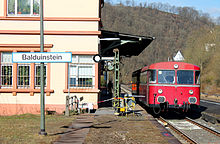
Limburg an der Lahn is the district seat of Limburg-Weilburg in Hesse, Germany.
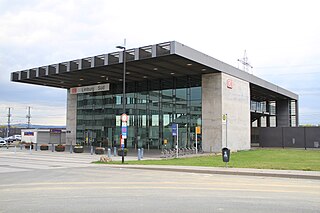
Limburg Süd is a station in the town of Limburg an der Lahn, in the German state of Hesse. It is located in the Eschhöfer Feld in the district of Eschhofen at the 110.5 kilometre point of the Cologne–Frankfurt high-speed railway. Limburg Süd is the only station in Germany that is served solely by Intercity-Express (ICE) services.
The Taunus Railway in the High Taunus is a railway route between Frankfurt (Main) Hauptbahnhof and Brandoberndorf via Bad Homburg, Usingen and Grävenwiesbach. It was operated from 1993 to 1995 by the Frankfurter Verkehrsverbund as the T-Bahn and subsequently by the Rhein-Main-Verkehrsverbund as line 15. It is listed in table 637 of the Deutsche Bahn timetable. The Friedrichsdorf–Brandoberndorf line, which has the infrastructure number of 9374, forms part of the old Friedrichsdorf–Wetzlar line, which was known as the Taunusbahn. The line is owned by the Verkehrsverband Hochtaunus. The infrastructure is managed by HLB Basis AG on behalf of the VHT.

The Main-Lahn railway, also called the Limburg railway, is a double-track, electrified main railway line in Germany. The 66.5-kilometer (41.3 mi) long line extends from Frankfurt Central Station (Hauptbahnhof) to Eschhofen, a borough of Limburg an der Lahn.

Limburg (Lahn) station is a station in the city of Limburg an der Lahn in the German state of Hesse. It is on the Lahntal railway, running between Koblenz and Gießen.

The Lahntal railway or Lahn Valley Railway is a railway line between Niederlahnstein in the German state of Rhineland-Palatinate to Wetzlar in Hesse, partly following the Lahn valley (Lahntal). Its western terminus was originally in Oberlahnstein. Trains now mostly operate between Koblenz and Gießen. The line was opened by the Nassau Rhine and Lahn Railway Company and the Nassau State Railway between 1858 and 1863 and is one of the oldest railways in Germany.

Niedernhausen station serves the municipality of Niedernhausen in the German state of Hesse. It is the most important station on the Main-Lahn Railway between the stations of Frankfurt-Höchst and Eschhofen in Limburg an der Lahn. It is the terminus of the Ländches Railway running from Niedernhausen to Wiesbaden Hauptbahnhof and of line S2 of the Rhine-Main S-Bahn from Frankfurt.

Eschhofen station lies on the Lahn Valley Railway in the town of Limburg an der Lahn in the German state of Hesse. In addition, just east of the station, the Main-Lahn Railway (Main-Lahn-Bahn) branches off to Frankfurt. The station was opened in 1863. It is classified by Deutsche Bahn as a category 5 station.

Niederlahnstein station is, along with Oberlahnstein and Friedrichssegen, one of three stations in the town of Lahnstein in the German state of Rhineland-Palatinate. It is a separation station on the East Rhine Railway and the Lahn Valley Railway and is located in the Niederlahnstein district and forms a public transport hub for the Rhine-Mosel-Lahn area.
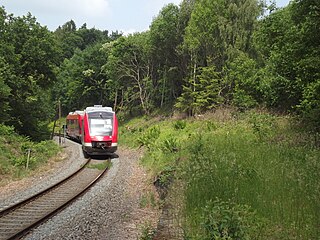
The Lahn-Eifel-Bahn is a rail passenger service in the German states of Rhineland-Palatinate and Hesse that runs as the RB 23 from Limburg an der Lahn via Koblenz and Andernach to Mayen, as RE 25 from Gießen via Limburg to Koblenz and as RB 38 from Andernach via Mayen to Kaisersesch.

Arfurt (Lahn) is a station (classified as a halt) in the Runkel district of Arfurt in the German state of Hesse on the Lahn Valley Railway (Lahntalbahn).

Aumenau is a station in the German state of Hesse on the Lahn Valley Railway (Lahntalbahn). It is located opposite the village of Aumenau, in the municipality of Villmar on the banks of the Lahn.
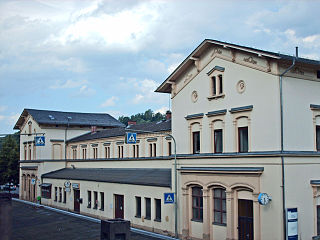
Weilburg is a station in the town of Weilburg in the German state of Hesse on the Lahn Valley Railway (Lahntalbahn). The Weil Valley Railway (Weiltalbahn) branched off towards Weilmünster immediately after the station from 1890 to 1988.

Leun/Braunfels is a heritage-listed station in the district of Lahnbahnhof in the town of Leun in the German state of Hesse. It is in the network of the Rhein-Main-Verkehrsverbund (RMV) and is located on the Lahn Valley Railway (Lahntalbahn). Directly next to the entrance building was the Braunfels terminus of the Ernst Railway (Ernstbahn) to Philippstein of which only a few remains are visible. It operated from 1875 to 1962.

Lauterbach (Hess) Nord station is a through station on the Vogelsberg Railway (Vogelsbergbahn) from Gießen to Fulda in the German state of Hesse. Until the closure of the Oberwald Railway (Oberwaldbahn) to Glauburg-Stockheim it was a rail junction.

Westerburg station is a junction station on the currently closed Herborn–Montabaur railway and the still operated Limburg–Altenkirchen railway. It is in Westerburg in Westerwaldkreis, in the German state of Rhineland-Palatinate.

Niederbrechen station is a station on the Main-Lahn Railway, which runs from Frankfurt (Main) Hauptbahnhof to Limburg (Lahn), in the Brechen suburb of Niederbrechen in the German state of Hesse. With Oberbrechen station, it is one of two stations in Brechen. The station is in the network of the Rhein-Main-Verkehrsverbund (RMV) and is classified by Deutsche Bahn as a category 5 station and has three platform tracks.
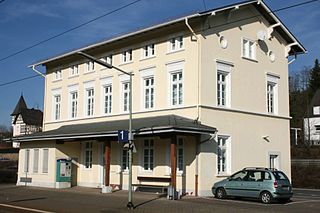
Oberbrechen station is a station on the Main-Lahn Railway, which runs from Frankfurt (Main) Hauptbahnhof to Limburg (Lahn), in the Brechen suburb of Niederbrechen in the German state of Hesse. With Niederbrechen station, it is one of two stations in Brechen. The station is in the network of the Rhein-Main-Verkehrsverbund (RMV) and is classified by Deutsche Bahn as a category 6 station and has two platform tracks.

Niederselters station is a station on the Main-Lahn Railway, which runs from Frankfurt (Main) Hauptbahnhof to Limburg (Lahn), in the Niederselters suburb of Selters in the German state of Hesse.

The Kreuztal–Cölbe railway is a 88-kilometre-long main line in Hesse and North Rhine-Westphalia, Germany. It branches off the Ruhr–Sieg railway at Kreuztal and runs via Erndtebrück, Bad Laasphe and Biedenkopf to Cölbe. Operationally, the line is now divided into two parts. The Kreuztal–Erndtebrück section is operated together with the Erndtebrück–Bad Berleburg railway as the Rothaar-Bahn and the subsequent section to Cölbe, now operated by the Kurhessenbahn, is called the Obere Lahntalbahn. Trains at the eastern end of the line run to/from Marburg (Lahn).

